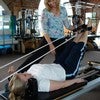Description
About This Video
Transcript
Read Full Transcript
Hi, I'm Jen as a fino and this is a Fletcher [inaudible] reformer movement session that I've designed based on my journey and climb back from a postnatal hood, which I assume that stage is going to last for the rest of my life. In any case, a lot of this work has to do with bringing both halves of the body back onto midline, a lot of connection through spinal articulation and a many different hemispheres of the body working as one. So let's start with some breath breathing in, reaching up
So let's inhale and exhale
And I'm really having to work the muscles of my legs to keep them lifted and not dropping to the floor. And from here, rolling down, hopefully to place myself perfectly into the shoulder or us and we'll bring the legs out from under the bar. We'll extend up to the ceiling or in a flex and point, we're just establishing a 90 degree angle at the hips, trying
So I'm looking to feel that I have a nice equal balance through the back of my pelvis and that my knee is coming along with me in space. Then I'm finding the carriage all the way home folding deep in the hip each time.
We're going to extend the leg to the ceiling, point the foot and go into some small leg circles. Cross midline, around and up.
Let's press all the way out and pull in. We've got eight presses here.
We're going to take the legs just a little bit wider than hip width, distance apart and inhale externally rotate and then exhale, go all the way past parallel to internal rotation, which I don't have a lot of, but I promise you I'm working those muscles. We're inhaling and exhaling and I'm just trying to feel like I could find the back of my hip socket. The little bit more depth through both ranges. One more and back to internal and then from here, come parallel. Bring the legs together. We're going to flex just the toes back in.
Place the balls of the feet on the bar. So we're in a high heel position. We're going to go into a pure form of stretch and then a little bit work pattern. So we bring the right leg up. We're going to deep, deep in the hip fold as much as you can. Certainly if you need to lower your heel to get your ankle over your need, go for it. We're crossing that right ankle over the left knee. Hips are stable on both sides of the body are long and we're going to pulse the knee open.
We're to bring the top leg to a parallel posse toe beside the knee and then extend the leg out over the bar as we come all the way in. So the pattern goes lift on one turnout, cross the ankle, bend on to come back out. Parallel on three, shoot the leg over the bar on four it goes. Inhale up, turn out and stretch
Last one, and here we go. Pressing out. Let's take a full breath just to find the opening of the hip, the rotation of that thigh bone and then come all the way in and we press back. Inhale and exhale is a really common to have more weight on the bent knee hip. So we really are trying to stabilize through that standing leg to keep a sense of equally weighting the pelvis. Also, not looking to talk, but really keep the lumbar spine long. The base of the pelvis waited. So let's come up, we'll come back into a parallel posse and then we'll shoot the leg out over the bar. So reviewing the steps, it's up on one turnout, stretch onto posse on three reach over and four lift.
Turn out in bed.
Pull the knees in and lower back down. Good, and we're going to rock up to take the foot bar all the way down and forward. Then we'll come back down. So I'm taking the hands into the leather straps. We're going into coordination patterns. The first one is with open-close and the second one is scissors. They're going to put a little tension on these straps here, shoulder blades down, and I have a full breath to extend the legs as low as I can.
As we reach the arms out.
Keep the carriage still and even press forward with the arms and then let the carriage move on the way down for threes.
Lower your left leg over the foot bar. Curl up a little higher. Pump the arms down. I'm going four three, two
[inaudible]
And place some spacers in that lumbar spine supported by the front. So we'll inhale and exhale
So our hinge doesn't take me off of my sits bones but rather keeps me connected to the mat and feels like links through the spine. So I want to feel my back long, my head in line and my hips really deeply contract it. And then I'm just going to come back up. So it's a small movement, but lots of coordination to move your spine in. One piece.
So turn your palms forward, open your chest, lean back, lean back, lean back, find the shaky point and come back to center. And one more time. Now from here, stay in the back hinge. Can you bring your hands to your knees and come into your contraction?
So we're trying not to move forward and back, but just change the shape on the same diagonal and then come back up and hopefully that's a good enough prep work to go into our next piece. So we're going to gather the straps and take a simple roll down through the center. Your heels can go on the outside of your shoulder rest and want to get nice and close to the shoulder. Ask themselves and then reach up nice and high on the straps. So we'll start rounded over. And this is just a prep to get our spine moving.
As I start to roll back, I'm going to bring my knees a little closer together as much as I can. Just to open up my back and feel myself rolling down and then I'm going to curl back up, deepening to come back to the top, rounding over, moving a little bit closer and adjust to where you can actually have movement happen. All right, so legs come back together. There we go. Squeezing, deepening, reaching, keeping my chest open and then working against the spring as well as with this spring to do the work to come up. When do you one more time [inaudible]
I'm going to take the hands into the straps. This is like a rowing series but a little different. So we'll start with the arms forward. We're going to contract back again from the tallest place. You really want to get out of your comfort zone, roll the hips back and draw the backs of the hands towards your chest.
So I'm in a very much the same shape that I was a moment ago when I was going between the hinns and the hinge and the contraction. Now from here I'm going to start the movement with my pelvis. I'm going to start to rotate my spine and I'm going to open the arms. So I'm on a back, hinged diagonal, and then the pelvis starts the motion back. The background, the hands come back to center. The subtlety is the control, but it's definitely a burner here. So we're reaching through the pelvis, extending the spine, opening the arms on the diagonal, and then finding the contraction to come back to center. Here it is with breath.
We're pulling that strap down against the leg and working the inner thigh up against the strop. And extending as much as we can and smiling and then contracting to come back to center and it's extension and reach.
We're going to come into a diamond and go into hug a tree p variation. So you've got this straps again and we're just trying to balance the pelvis instead of crossing the ankles. So I'm going to bring my arms up into a hug position. Just start with four hugs forward and really concentrating on this stretch after all of that work for the back. And I like to think of my pelvis lifting up higher than the shoulder rests, so I don't get the urge to rest back against them, especially after that last exercise. All right, so let's add on.
We're going to hug forward. Inhale, it's an exhale to a high release, a chest on the ceiling, a very concentrated back. Ben from here, open the arms, stretch the chest open, and then we're connecting through the abdominals to come back. So a lot of times from the back bend to go forward, it will be a shift without actually shortening the front line in lengthening the backline back to a centered position. So let's try that again and again, finding the subtlety in the control. So we inhale. Exhale, lift back. Ben
So now we're ready for some kitty cats. So let's cross the ankles. We'll bring the foot bar back up to a low position and we're going to be on two springs and come forward into our cap position. We are going to go into a exercise called Tucson cat, which is an extension exercise and flection, little different than the knee stretches. So I really work hard on getting the bottoms of my toes to open up so I can get my heels as close to the shoulder rest as possible. And then I'm going to start knees, hip width, and around did spine open hands to really feel the heel of my hands connect to the bar. So we start with the pelvis tilting forward, lifting the tailbone up. So our initiation is a little pelvic tilt.
So I think we'll do that a couple of times. Let's round just the pelvis tail tilts up, sitz bones reached back and we'll round again. It really helps me feel both sides working together. Until now. Let the tilt start to take you into extension and as you extend, reach your chest down to the springs, continue to tilt up hello springs and try to find a nice yawning position. How does just in line with the spine and then as we come back in till the tail downward, rounding upward and find a lift up and off.
It's just yummy if you do it the right way. So we inhale and exhale. If we think about the way that the cats and dogs move, they really don't think too much about it. They just let everything stretch and enjoy it. So try to find that same energy as you go through your motions.
I just have my hands supporting me like a plank and really everything else is driven by my spine. I think we'll do one more. Let's circle the arms back to the shoulder as, let's press the hips open and just take a moment here to open the chest, open the hip flexors, lift and open the throat and come back. So we're going to take this Tucson cat into something I call three 60 cat, which is a little more rounding inflection of the spine and a little shifting right and left hemisphere. Start in the same position and the pelvis is going to shift to the right evenly, hopefully like the carriage of a typewriter.
So more weight is on the right name. Still reaching the left knee down. Start extending the hips, let that carry through to the spine. Draw a semi-circle on the ceiling with your tailbone as you shift your hips to the left and then contract to pull in. And then we'll just reverse it. So hips reach, tailbone reaches up and round to come in.
[inaudible] [inaudible]
So the next version goes into a hole and a lift. So we're taking a full breath. Press out to a place you can sustain. Lift your heels up without moving the carriage with your sitz bones higher. Deepen your hip fold to pull all the way into the stoppers and then lower all the way down through your heels. Full breath.
So we rise up on the balls of the feet. Press with the backs of the legs to go out, hopefully to a place where you can lower your heels without letting that carriage move. And then dig the heels under to come in. Here we go again. You can try to go farther each time, but make sure you can use the power of those legs to keep the spring still. Last time all the way in. That was good. Let's take one spring off from here and we're going to walk forward.
Marina go into Ford elephant and I'm being generous with the one spring drop. You can try this on too if you feel the need to challenge yourself more than this is already challenging, so we'll round over. We're going to take flection through the spine now, lifted the toes up and we're just going to press back without losing that flection and then deep in the belly to pull the carriage back in. Keeping the shoulders grounded back at the neck long and for me working on not hyper extending those legs but really pressing from my muscles rather than the joints. Do One more here. Let's tilt the tail extend through the spine. So we come to as much of a flat back position as we can.
My body slightly over the foot bar and I'm going to press the legs back. Once again. Body stays, legs move. Opening the hips as much as I can without moving the pelvis. Folding to increase the stretch.
Go ahead and take the foot bar down and then take a roll up with bent knees to come up to standing. Okay, so we're going to turn and bring the outside foot onto the wood-frame or the step. If you have one on your reformer, if you are on the, you want to align your foot up like it's on an ice skate. So you're not letting your heel fall too far in or outside of the frame. And then we're going to heel toe with care out to a place that feels like it is work to hold the kerogen. So for me, where I'm working with my pelvis, it's a little more narrow than I would have a couple of years ago, but this is where I can find strength versus I'm working into a weakness and I want to stay in strength. So I'm going just going to take the arms down, I'm going to work some side splits into a standing saw. So we'll inhale to press out as far as we can. Think of the heels moving apart and the toes pulling back together.
And of course my challenge is always keeping my side bolts level. So I try to see if I can fire them out up before I press out in fire, my ad doctors to come in. So I'm not just sliding on the springs lifting up through the front and reaching down through the tail end last when reaching out and then let's hold it out. So from here we're going to take the hand that's farthest away from the wood, stabilize the carriage and slice it across the body. Hopefully keeping the pelvis still contract around down. You're going into a standing saw, very hard work to manage.
We're coming up articulating through the spine, trying to feel the bend through every bone and unfolding the arm. Let's go to the other side.
Then get a buddy and tell you how you can do it better and roll all the way up and reach and they were going to press out and pull all the way in and I'm going to let that be my set for today. I'll do it facing the opposite direction, so we'll step on. Sometimes you have to just recognize where you're at today. So turn to face the other direction. Placed the ice gate on the left foot. Open out to a place that feels challenging. Find length. We'll go out for four
Quivering the legs and finding center. Here we go. [inaudible] this will be my last one.
I really like this way of getting into the semi-circle because it's a little less labor intensive on the shoulder. So I just kind of perched myself on the edge. I'm going to roll down back to the mat, find the shoulder rest, pushed the thighs into the foot bar and slide the arms back overhead to really find my position. And then I'm working at anchor Mike shoulder blades, my upper thoracic spine. And by anchor I just mean give weight to you, don't mean locked down. So then from here, climb back up. I'm gonna find my narrow turnout and open up those hips and that feels really lovely. I am going to make sure that my hands are hot light and then my shoulder blades are active.
And then as much as I can try to pull that carriage in a little bit more. So I am not working with the staffer, but I'm going to try to stop myself. Let's see what happens. So no press out finding the strength through my hamstrings. And from here just hovering away from the edge of the carriage, we're going to roll down through my upper back and reach the hips through this spring.
So I feel like this is one of the limited places you can really go for full extension. So let's go there. Fold in the hips to come in as close as you can and then curl under, scooping up to the top. So again, pressing out from the hamstrings, keeping the hips high, trying to send the chest down, the thoracic, then the Lumbar, then flip the tail over, fold in the hip.
Take the feet over the top. This is a nice place just to rest, Kinda hang out and let those hips go. And then we can pull the carriage all the way back over and rest. And I always like to give myself just a moment for my spine to accept the information that I just gave it, which was a lot. So let's reach the arms up. We'll just inhale and exhale. Let the shoulders be heavy. Open the arms out and reach to the ceiling.
Comments
You need to be a subscriber to post a comment.
Please Log In or Create an Account to start your free trial.





































